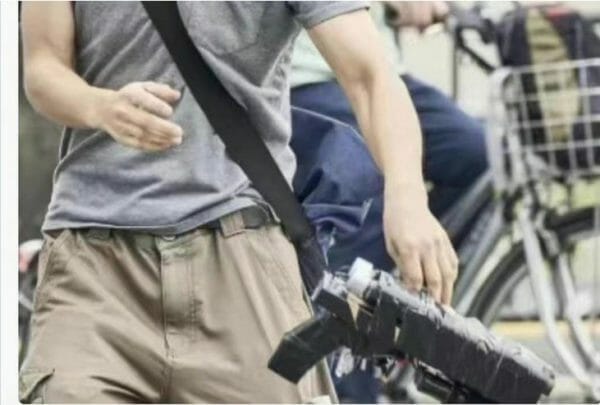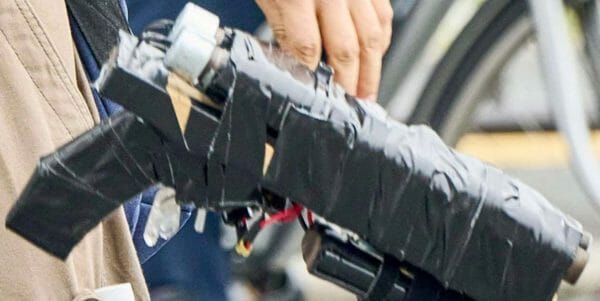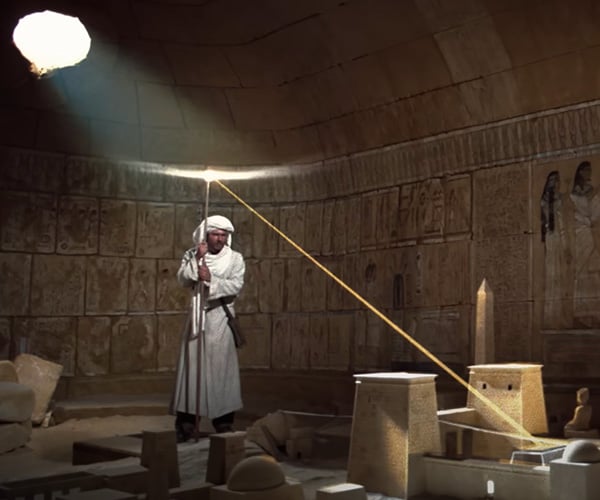https://www.ammoland.com/wp-content/uploads/2022/07/Homemade-Gun-Abe-Assassination-Twitter-731–500×337.jpg

U.S.A. –-(AmmoLand.com)-— Former Japanese Prime Minister Shinzo Abe was assassinated with a homemade gun on July 8th, 2022, in the Japanese city of Nara.
From video of the event, it appears the assassin fired his weapon at Abe from a distance of 20 to 30 feet. The two distinct shots were fired about a second apart and produced copious amounts of white smoke.
Early reports were of wounds to the neck and chest. It is unknown what sort of projectiles were used in the homemade weapon.
Such firearms are extremely easy to make for anyone with a rudimentary ability to use hand tools.
This correspondent made several similar homemade, electrically actuated, multishot, muzzleloading black powder firearms 40 years ago. Electrical firing mechanisms are much easier to make than percussion systems used in modern firearms. A simple switch is a trigger for each barrel. Batteries supply the power to ignite each charge. If you want multiple shots, multiple barrels are used. A nine-volt battery worked well in my 40-year-old experiments, as did a four-pack of AA batteries.
A simple galvanized water pipe is plenty strong to withstand black powder pressures for a few shots. The firearm used in the assassination appears to be close to a 12 gauge bore size. Larger bores and projectiles create sufficient energies at the lower velocities on such firearms.
The propellants for such guns are easily made at home. Many high school students successfully made black powder in my youth. Fireworks can be disassembled as another source of propellant. It has been reported that people in prisons and the former Soviet Union used ground-up match heads as a propellant. Making propellant is much more dangerous than making the guns.

This correspondent disagrees with professor Daniel Foote of Tokyo.
“This actually shows the extent that Japan gun laws are working,” said Daniel Foote, a professor at the University of Tokyo specializing in law and society. “Very few people have the ability to create such a weapon.”
It is unlikely the professor has ever done the experimental work to make such weapons. Forty years ago, this correspondent was able to make a four-shot repeater from 12 dollars of materials obtained from a hardware store and Radio Shack, using about 12 hours’ worth of labor. In order to be effective with such weapons, testing and practice is necessary. It appears the former Naval officer did the preparation required.
Police found several possible explosives during a raid on Yamagami’s home, and the suspect confessed that he had “manufactured multiple pistols and explosives so far,” NHK said.
Other local reports said that he told cops he initially planned to blow up Abe, but decided to instead build a gun because he feared a bomb was less reliable.
Some sources are saying the assassination occurred at 10 feet. In the video referenced above, the distance appears to be 20 to 30 feet. There did not appear to be any sights on the homemade firearm. Today, some sort of laser pointer would be easy to install and bore sight. But NO mention of a laser has been made to this correspondent’s knowledge.
The successful assassination of former Japanese PM Abe, with a homemade firearm in a country with some of the most extreme firearms restrictions on the planet, shows how difficult it is to regulate what is essentially a 15th-century technology.
About Dean Weingarten:
Dean Weingarten has been a peace officer, a military officer, was on the University of Wisconsin Pistol Team for four years, and was first certified to teach firearms safety in 1973. He taught the Arizona concealed carry course for fifteen years until the goal of Constitutional Carry was attained. He has degrees in meteorology and mining engineering, and retired from the Department of Defense after a 30 year career in Army Research, Development, Testing, and Evaluation.

AmmoLand Shooting Sports News


